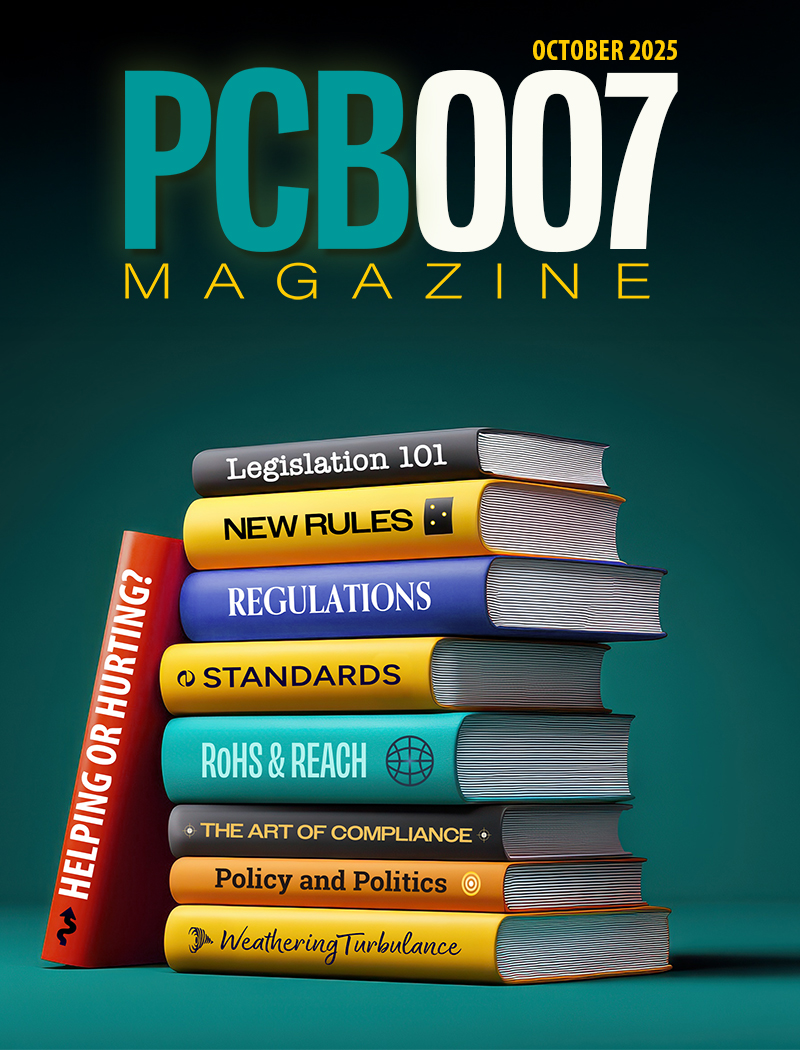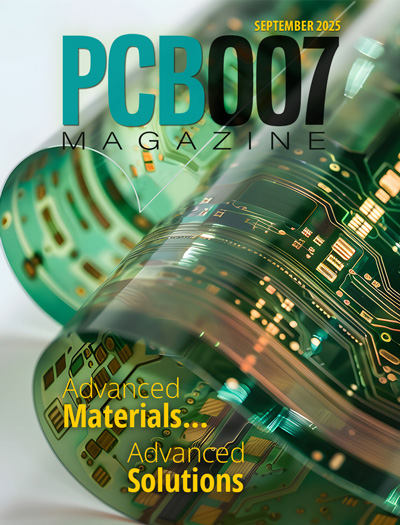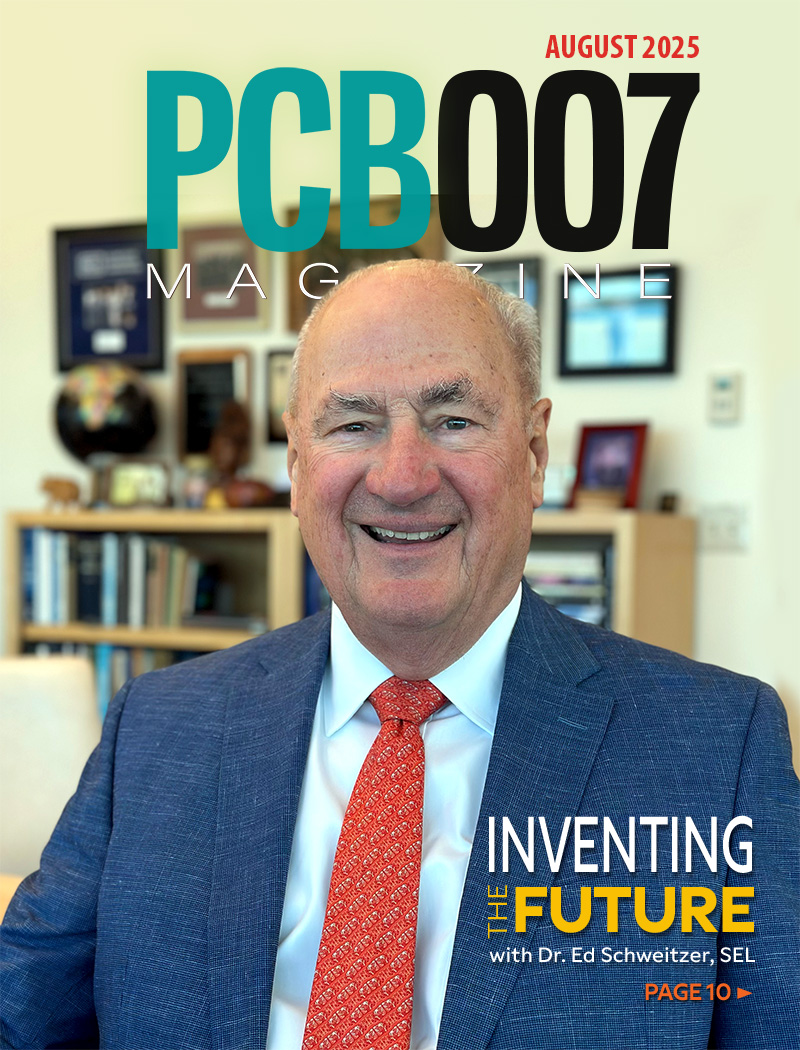-

-
News
News Highlights
- Books
Featured Books
- pcb007 Magazine
Latest Issues
Current Issue
The Legislative Outlook: Helping or Hurting?
This month, we examine the rules and laws shaping the current global business landscape and how these factors may open some doors but may also complicate business operations, making profitability more challenging.

Advancing the Advanced Materials Discussion
Moore’s Law is no more, and the advanced material solutions to grapple with this reality are surprising, stunning, and perhaps a bit daunting. Buckle up for a dive into advanced materials and a glimpse into the next chapters of electronics manufacturing.

Inventing the Future With SEL
Two years after launching its state-of-the-art PCB facility, SEL shares lessons in vision, execution, and innovation, plus insights from industry icons and technology leaders shaping the future of PCB fabrication.
- Articles
- Columns
- Links
- Media kit
||| MENU - pcb007 Magazine
Estimated reading time: 5 minutes
All About Flex: Customer Acquisition
How good is your process for finding and capturing new customers? In the world of electronics, this challenge is often a key ingredient to business success. It is estimated that the average life cycle of an electronic product is between four and five years. How long have you owned your current cellphone? This relentless churn of new products has a profound effect on companies producing the components (like printed circuits, connectors, displays, etc.) required to build the myriad of today’s high tech electronic products. With this short product life cycle, simple math suggests manufacturing companies might expect about 20–25% of the part numbers they produce to become members of the e-waste pile in any given year. Which is another way of saying, “Time to find some new customers!”
The “Customer Acquisition” process can be thought of as consisting of three major segments: collection, selection and execution. While these sub-divisions should be considered as intimately interrelated, examining them as separate disciplines can be enlightening.
Collection
This broadly describes the marketing process. How are new customer opportunities discovered? Word of mouth is one way, and as start-up companies become established it is a critical element. A positive customer experience often multiplies goodwill as new generation products are developed and word is spread across an industry. The names and faces of buyers and engineers frequently show up within differing companies in the same industry so a positive (or negative!) customer experience is often transferred as employees move from one company to another. But as companies mature and are challenged to grow beyond a regional customer base, an expanded marketplace visibility is necessary. This challenge is compounded as component suppliers are most often building custom products and selling customized engineering. As such, the supply base needs to make customers aware of capabilities, which differs from marketing to an end user. This presents a unique challenge (i.e., how to make potential customers aware of your capabilities rather than the end product you supply).
Getting capability and visibility out to the world of design engineers can be done in a wide variety of ways. Several examples include:
- Advertising in online trade magazines (like The PCB Design Magazine) and on the Internet
- Exhibiting at trade shows
- Attending industry events and joining professional organizations
- Paying Google for position rank
- Using SEO strategies to rank highly for organic search
- Utilizing an outside sales function. Most times this is in the form of a manufacturer’s rep paid on commission
- Contacting prospective customers with an inside sales function
- Distributing literature (design guides, datasheets, etc.) and mailing out sales samples
- Content marketing (non-commercial technical information that is highly useful to your target market, such as blogs, published articles, white papers, etc.)
These methods are intended to make a company highly visible, hopefully during the design phase of a new project. Since the sale is intended to take advantage of a supplier’s capabilities, the earlier the involvement the better value the supplier can provide.
Selection Once the opportunity has been collected, a determination about engagement occurs. This section of the customer acquisition process often begins with a request for quotation (RFQ) from a potential customer. Vetting the opportunity requires consideration of several metrics such as size of the project, size of the customer, potential for future business, engineering resource requirement, and estimated profit margin. These are measures of the desirability of the business and are considered as part of the selection process. Creating a checklist with these factors is a common practice for determining pricing. The multiple dimensions represented by this information are considered as a supplier decides if and how to generate a quotation. The offer of a price per various quantities is the final method used to select a customer. Most printed circuit fabricators employ a staff of applications engineers who are tasked with completing the selection function. This is truly the ‘point of the arrow’ as they try to balance customer needs and supplier capability. The applications engineering group is challenged to have one foot in the factory and one foot representing the customer. Determining the Goldilocks (“just right”) price means the supplier realizes a reasonable profit and the customer is pleased with the value received.
Execution The execution phase describes how the project is managed after the customer’s order is received. On time delivery and cycle time are key metrics during the execution phase. Suppliers that can consistently meet expectations will enjoy new part number opportunities. In the world of flexible circuitry, job set-up and CAD get the part ready for production and the operations team schedules and builds the part. Although building the initial prototype parts is often not considered part of the sales organization, success at this phase can certainly have a lot to do with customer acquisition. Making the sale and prematurely assuming program responsibility has been successfully transferred to operations is often a recipe for failure. Ownership of a project is best retained with a sales/applications engineer at least until the initial parts are delivered successfully. In a world of timebased competition, fabricators focused on cycle time reduction are in step with customer’s basic requirements.
Collection, selection and execution can be thought of as three legs of a stool. Being good at only one or two will make success a difficult balancing act at best. Describing the customer acquisition process with these three segments helps define roles played by various departments and functions. Metrics describing performance success vary from segment to segment and performance tracking can be insightful.
As new part numbers and customers place orders, the customer acquisition segmentation helps people understand their critical role in the organization’s success. It also helps measure
what is done well and where improvement is needed. A good way to view this model is to believe the statement, “In our business, everyone is a salesman.”
Dave Becker is vice president of sales and marketing at All Flex Flexible Circuits LLC. To read past columns or to contact Becker, click here.
Editor's Note: This column originally appeared in the December 2016 issue of The PCB Magazine.
More Columns from All About Flex
All About Flex: Terms and ConditionsAll About Flex: ISO 9001 Basics
All About Flex: FAQs on UL Listings for Flexible Circuits
All About Flex: Avoiding Trace Fracturing in a Flexible Circuit
Polyimide vs. Silicone for Flexible Heaters
All About Flex: Copper Thickness Requirements for Flex Circuits
All About Flex: Copper Grain Direction
All About Flex: Options for Purchasing Flexible Heaters


